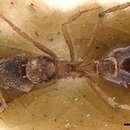en
names in breadcrumbs


Brown and Wilson (1959) summarize the genus as follows: "Widespread in tropics and warm temperate areas. Primarily forest-dwelling; some species occur in grassland and arid scrub. ... Nests mostly in soil and rotting wood; a few species live in arboreal plant cavities in tropical rain forest. Foraging hypogaeic to epigaeic-arboreal. Food: most species are collembolan feeders; a few are polyphagous predators or occasionally feed on sugary substances..."
Members of the genus are all predaceous, with a kinetic mode of attack (Bolton 1999).
Workers of godmani are dramatically large for a Strumigenys. Individual workers may be found day or night on rainforest floor, on rotten wood, and under loose bark. I have never observed this species in Winkler samples, including samples from the same locations where individual workers are collected by visual search. This could be due to their somehow being undersampled by litter sifting, or, more likely, they are actually at much lower density than most Strumigenys species, but their large size makes them oversampled by visual search. Brown (1962) found a nest in Panama in a small rotten log in cloud forest.
Costa Rica, Panama, Colombia, Ecuador, Venezuela, Guyana. Costa Rica: Atlantic slope to 500m.